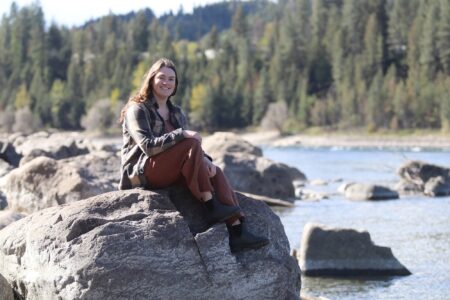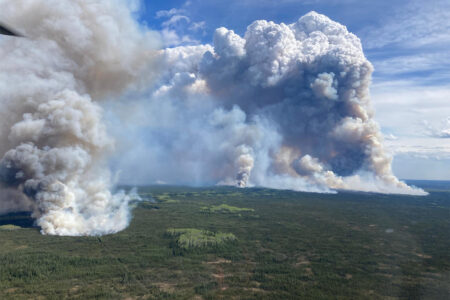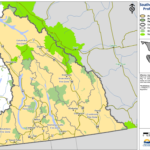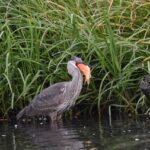OPINION: Province divided on deer research
The purpose of the newsletter is to give you information that showcases the collapse of integrity in the management of the province’s wildlife resource.
Two polar opposite meetings took place recently that demonstrates the pathetic leadership of two biologists compared to the good counsel and advice of two Forest Practices Board employees.
The whitetail deer cull results after the November civic election were approximately 900 votes for a cull versus approximately 600 against so as a consequence the May 19 Grand Forks City Deer Committee meeting was primarily about constructing a motion to be presented to the Grand Forks city council requesting the resources to implement a suggested cull of 80 whitetail. My primary focus as a deer committee member who does not support a cull was to convince the deer committee to make a public statement that states the obvious- the whitetail deer population on their historic range thanks to the five year whitetail doe rifle season has resulted in a 90 plus percent population decline.
After and during the meeting I spoke to retired biologist, Brian Harris and current biologist, Craig McLean who have consistently been steadfast as is Director of Wildlife, Dan Petersen that because the whitetail deer field counts in the main Kettle River watershed have not declined therefore the whitetail doe rifle season has not negatively impacted the animal. Whatever the sum of the reasons this scientific assumption is completely false, a fact supported by substantial anecdotal information!
On May 22 I participated in a field trip that included two Interfor employees, Doug Noren and Randy Waterous and Forest Practices Board employees, Rob Thompson and Glen Pilling. Although my Forest Practices Board complaint is an ongoing story for a future newsletter the thoughtful questions, information and leadership provided by both Glen and Rob I have not witnessed from wildlife managers since the 1994-96 West Kootenay Boundary Commission on Resources and Environment. The subsequent report will describe my point.
A few years ago I called biologist, Brian Harris a liar because of his consistent statistical argument that in effect justifies the liberalized hunting seasons that are one of the major reasons the Boundary herd population has collapsed. I retract that statement. My recent conversation with both Brian and Craig McLean made it very clear that neither have the gravitas, depth or measure to make a call on wildlife management.
The red flags have been conveniently ignored: extremely small road kill compared to past decades even though there is much more traffic; wildlife sightings adjacent to roads and in fields are down dramatically; The Report and Declaration of Guide Outfitter that gives the vital information on a non-resident hunt will show a decline in harvest compared to past decades and the critical important anecdotal information from credible land owners and concerned citizens has been ignored.
Remember that the scientist is expected to have a curious mind and be a master of how, who, what, when and where in the field of his expertise. Needless to say without transparency and accountability the province’s wildlife resource has a grim future.
It is also important to remember failure is a larger fact of life than success. Statistics Canada regularly reminds us that 80% of small businesses-100 employees or less fail within their first five years.
The other side of the equation is equally as brutal! A university professor thirty- forty years on concluded after extensive research that people in hierarchical organizations like bureaucracies are eventually elevated one position beyond their level of competence. He called his theory the Peter Principle.
I further remind you that on page 14 of the current Hunting and Trapping Synopsis: It is an offence for we the people to make a false statement to an officer, conservation officer or constable.
The most telling information I have that challenges the economic and scientific madness that has destroyed the Boundary deer herd consists of two short easy to read 1987 reports by biologist, R.C.Lincoln and A.D.Peatt. You can find both reports on our web page: wildlife heritageforever.com
If you are an ardent hunter or a concerned citizen I recommend you read the reports. The one sound byte of many that challenges liberalized hunting of the province’s wildlife resource I used in a letter to the editor that appeared in the Vancouver Sun April 29th; “In the Okanagan where roads are abundant, suggesting a potential for localized overharvest and where the wildlife management staffing capacity does not allow for careful monitoring of local deer herd status it is prudent to be fairly conservative in harvest strategy.”
Another insightful quote conveniently ignored by current wildlife managers and the BC Wildlife Federation in Al Peatt’s report on page one- “Our agency still suffers public criticism caused by poorly per ceived antlerless kills in the 1950s and 1960s. This proposal is far from that situation and is deserving of your full support because it will benefit both deer and hunter.”
When Al and Bob were hired as biologists in the early eighties there was no doe deer hunting opportunity so as a consequence of mild winters and a low cougar cycle the deer herd population increased. Al Peatt’s rationale is well explained on page 1 of his report titled An Improved Deer Harvest Strategy for the main Okanagan Valley “The Strategy outlived here is conservative. It will not lead to over exploitation of the deer resource. A Limited Entry Whitetail Doe Season was implemented.”
If you read the reports you will notice that the biologists were worried that BC Wildlife Federation Clubs in the Okanagan would not support the hunt. This point was made in Bob Lincoln’s Report on page 2 “A prime concern of these Federation members is that the deer resource not be over-exploited. They have lobbied hard for very conservative harvest of deer”. As a consequence of the implementation of the conservative antlerless Limited Entry Hunting Program , the BC Wildlife Federation clubs in the Okanagan quit participating in the Okanagan Boundary Wildlife Advisory Roundtable. A generation on the BC Wildlife Federation is a shadow of its former self!
How is it possible that there is more hunting opportunity for whitetail and mule deer in Region 8 Okanagan/Boundary in 2015 compared to 1987 when the access and quad bike hunters have dramatically increased?
DEER SEASONS in the BOUNDARY-MANAGEMENT UNITS 8-12, 8-14, 8-15
1987-Rifle season any whitetail buck= 67 days
2015- Rifle season any whitetail buck= 82 days
1987-Rifle season whitetail doe= conservative number of Limited Entry Hunting Permits
2015- Rifle season whitetail doe= 21 days
1987- Archery only season buck only= 9 days
Any sex= 9 days
2015- Archery only season- buck only= 9 days
Either sex= 20 days
1987- Rifle season any mule deer buck= 52 days
2015- Rifle season any mule deer buck= 0 days
4 point bucks = 62 days
1987- Rifle season mule deer doe == none
2015- Rifle season mule deer doe = none
Limited Entry permits =15
1987- Archery only mule deer buck =9 days
Any sex = 9 days
2015- Archery only season mule deer buck= 9 days
Although population estimates for ungulates prior to hunting seasons are not new the BC Ungulate Regional Population Estimates and Status- preseason 2014 Report which you can find on the Ministry of Forests, Lands and Natural Resources web page once again are a farce for whitetail and mule deer populations in Region 8. Okanagan/Boundary
Mule Deer- 28,000 to 42,000
Whitetail Deer- 31,000 to 44,000
Both Populations are described as stable
These numbers are nothing less than sophisticated dribble and every hunter I have spoken to laughs at these numbers.
It is important to remember that in the early eighties at a wildlife hearing in Victoria, one of British Columbia’s prominent trial lawyers, Terry Robertson forced Region 2 biologist Bob Forbes to admit he was lying about black bear population estimates.
If you know squat about American politics than you would be familiar with a quote connected to former Republican President, Ronald Reagan- “Trust but verify”. Steven Fletcher the conservative quadriplegic MP from Winnipeg used this quote when describing the Canadian Senate Scandal.
Dana Base, the senior biologist for the NE corner of Washington State describes population estimates as part art part science. When I told him that after five years of three-week whitetail doe rifle seasons you see very few whitetail deer on their historic range and yet the current population for Okanagan/Boundary is 31,000 to 44,000 his response was “It does appear something is wrong”.
The farce of the 2014 population estimates is that the 2011 preseason population estimates for mule and whitetail in Okanagan/Boundary are virtually the same. Mule deer- 28000-42000
Whitetail- 31000- 44000
So why has there been no attempt to verify these outrageous numbers when every credible deer hunter in Region 8 knows they are not true? I suspect former Director of Wildlife, Ian Hatter knew the whole process was a farce when he made the following comment on page 27 in a September 17, 2009 report titled Mule Deer and Whitetail deer Population Review for the Kootenay Region of BC. “The single factor controlled by the wildlife manager is hunting regulations and these are often changed for reasons other than data quality. No perfect index appears to exist to measure population change so all indices discussed must be viewed with some skepticism and are best used in concert with other population data”
A few months ago I had a conversation with two Washington State hunters, both who I know because they have hunted with hounds for 30-40 years.
Ron Warren is a First Nation hunter who lives on the large Colville Confederated Tribe Reserve south of Republic. I was surprised with his answer when I said everyone in my circle believes the mule deer and whitetail have declined 90% in the last 30 years. His response-same here! Then he said I guide hunters in the SE corner of the state and I do very well because I hunt on private property.
Richard Eich lives in Republic and he claims the mule deer are down 70 per cent in his time and the whitetail are still okay. I then told him that although BC ungulate specialist Gerald Kuzak admits the mule deer population in BC is in serious decline but there has never been a public statement from wildlife managers or the Minister of Forests, Lands and Natural Resources, Steve Thomson or his senior staff every time a community complains about mule deer. Richard’s response-same here!
I reminded Richard that there was a major agriculture/rancher agenda demanding a dramatic reduction in deer and elk populations. Richard’s response-same here!
Rather than quote from the Western Producer, an agriculture/rancher publication I will send you the paper.
Remember that in2005 the BC Liberal Government hired David Borth, the Executive Director of the BC Cattlemen’s Association to oversee the province’s range bureaucracy. I also remind you that Amanda Lang a well-respected CBC TV reporter in an April 8, 2015 conversation with Ed Broadbent the former National Leader of the NDP said “To-day Canadians believe politicians are liars seeking election so they can help their friends!”
Agriculture/ranching complaints publically vetted come to nothing when complainants know their agriculture/ranching behavior will be thoroughly scrutinized.
If you take the time to scan “Is this the beginning or the end of the North American Wildlife Model?” you will find that it is an easy read that is all about power points. Here are some of the power points BC hunters can readily connect with:
Whitetail and turkey are thriving on private lands east of the Mississippi.
The western United States- public land states- herds are dramatically declining.
Mule deer populations are down 50 to 70 per cent throughout the west.
Elk herds are down 50 to 70 per cent in several Idaho, Montana and Wyoming wilderness areas.
Moose hunts have closed in Jackson and Cody Wyoming.
Some herds of Caribou and moose in Alaska are in dramatic decline.
Stone sheep are down 50 per cent in BC.
Pheasants have disappeared from Idaho and Utah.
How do hunters respond?
- Utah: archery vs. rifle vs. muzzleloader
- Alaska: Native vs. Native residents vs. non-residents
- British Columbia: Guides & Outfitters vs. local hunters.
Who gets to shoot the last Animal!
Barry Brandow Sr.
























